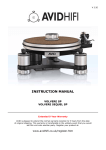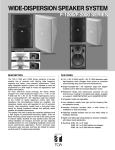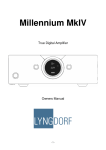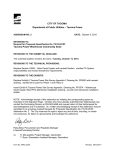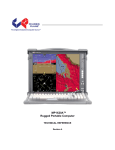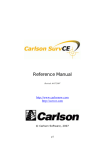Download Seiko FB 390 User manual
Transcript
MICROLINE 320/390FB User Manual (English) MICROLINE 320/390FB User Manual (English) English Table of Contents Note to Customers ................................... E-2 Important Safety Instructions .................. E-3 Important Wiring Instructions ................. E-4 Installing Your Printer ............................. E-5 Preliminaries ............................................ E-6 Connecting to the Computer .................... E-9 Installing the Ribbon Cartridge ............... E-10 Loading Paper .......................................... E-12 Loading Continuous Paper ...................... E-12 Loading Cut Sheet paper ......................... E-18 Setting the Top of Form .......................... E-20 Positioning of the Printer ......................... E-21 Running a Self Test ................................. E-22 Printing Demo Patterns ........................... E-23 Changing Menu Settings ......................... E-24 Specifications........................................... E-26 E–1 Note to Customers Every effort has been made to ensure that the information in this manual is complete, accurate and up-to-date. Oki assumes no responsibility for errors beyond its control. Oki also can not guarantee that changes in software and equipment made by other manufacturers and referred to in this book will not affect the applicability of the information in this manual. Copyright 1994 by Oki. All rights reserved. Microline is a registered trademark of Oki Electric Industry Company Limited. Epson is registered trademark of Seiko Epson Corporation. IBM, PC, Proprintere XL and Graphics Printer are registered trademarks of International Business Machines Corporation. MS-DOS is a trademark of Microsoft Corporation. E–2 Important Safety Instructions Your printer has been carefully designed to perform safely and reliably. However, as with all electrical equipment certain precautions should be allowed: ➢ Read all documentation supplied with and on the printer before commencing. ➢ Always disconnect the printer from the mains source before cleaning. ➢ Be certain that your power source matches the rating listed on the back of the printer. If you are using an extension cord, ensure that the total rating does not exceed 15 amperes. ➢ Your printer has an earthed 3-pin plug, DO NOT use this plug with a socket that is not earthed. ➢ DO NOT make any adjustments, other than those outlined in this manual, it could damage the printer. If you have persistent problems with your printer, switch off, disconnect from the mains source and contact your dealer for assistance. E–3 Important Wiring Instructions The wires in the mains lead are coloured in accordance with the following code: Green and Yellow Blue Brown Earth Neutral Live If the colours of the wires in the mains lead of this printer do not correspond with the markings of the terminals of your plug, proceed as follows: Green and Yellow must be connected to the terminal marked with the letter E (or the safety earth symbol) or the terminal coloured Green or Green and Yellow. Brown must be connected to the terminal marked with the letter L or coloured Red. Blue must be connected to the terminal marked with the letter N or coloured Blue or Black. Warning: This printer must be earthed. If you are in any doubt regarding the wiring, please contact a qualified electrician. E–4 Installing Your Printer Prior to unpacking the printer, find a flat, sturdy surface to place it on, for example, a desk, printer stand, etc. Gently remove the printer from its carton. Make sure you have everything shown below: ➢ ➢ ➢ ➢ ➢ MICROLINE 320/390 FLATBED printer Sheet stacker Power cord Ribbon cartridge Printer Handbook ! Note: Save the box and all packing material. Repack the printer when planning to transport it long distances, in order to protect it from rough handling and damage. ! Note: You can purchase an interface cable and paper for the MICROLINE 320/390 FLATBED from your dealer. Sheet stacker Ribbon cartridge Printer Printer handbook Power cable ln the unlikely event that anything is missing or damaged, contact your dealer immediately. E–5 Preliminaries Before plugging in the printer, follow these steps to install your printer. 1. Hold both sides of the access cover and lift up. There is a shipping retainer to protect the printhead from jamming. Remove this shipping retainer and keep it with the other packing materials. (To transport the printer long distances, make sure to re-install the shipping retainer). Close the access cover. Access cover Shipping retainer E–6 2. Next install the sheet stacker. Put the stud of one of the stacker’s legs into the hole at the end of the rear vent. Gently press the other leg until it slips into the other hole. 3. Make sure the power switch is OFF. Plug the power cord into the back of the printer. Plug the other end into an earthed socket. 4. Turn the power switch on, and check that the POWER lamp and the ALARM lamp are illuminated. If paper is loaded, the POWER lamp and the SEL lamp will be illuminated. E–7 5. Turn the power switch off. ! E–8 Important: Make sure the socket is earthed. Do not use an adapter because it will defeat the earthing. Connecting to the Computer These instructions are for the standard centronics parallel interface. 1. Make sure that both the printer and the computer are switched OFF. Wire clips Parallel interface cable Parallel interface connector 2. Plug the interface cable into the port on the back of your printer. Fasten the the cable using the wire clips that can be found on both sides of the connector port. 3. Plug the other end of the cable into the printer port of your computer. E–9 Installing the Ribbon Cartridge 1. Set the headgap lever to the “R” position. 2. Open the access cover. 3. Slide the print head gently towards the centre to give yourself some working room. There is a cut-out at the centre of the sheet guide for changing cartridges. Headgap lever Printhead Sheet guide Cut-out ! Important: a) The printhead gets very hot during extended periods of printing, be sure to let it cool off before you touch it. b) Make sure that you are using the correct ribbon. If you attempt to use any other ribbon it may cause print quality problems. 4. Hold the ribbon cartridge with the blue take-up knob facing up. E – 10 5. Insert the flat end of the cartridge into the upper part of the ribbon plate, then lower the front of the cartridge over the printhead until it snaps into place. Ribbon plate Blue take-up knob 6. Turn the take-up knob in the direction of the arrow icon to tighten the ribbon. 7. To remove a ribbon, move the cartridge to the position indicated by two arrow icons at the bottom of the cartridge then lift it out gently. E – 11 ! Important: Do not peel off the plastic film (ribbon mask) on the top of the cartridge. Do not stack the ribbon cartridge sideways, it will cause poor quality printing. Loading Paper Loading Continuous Paper 1. Check that the POWER lamp is turned on. 2. Check that the SEL lamp is turned off. If it is lit, push the SEL button once to turn it off. ! E – 12 Note: You cannot print continuous paper and cutsheets at the same time. If a cut sheet is already loaded, pull the paper lever forwards, and press the FORM FEED button while the SEL lamp is on. The cut sheet will feed automatically. 3. Push the paper lever to the continuous paper position. Paper lever 4. Adjust the headgap lever on the left side of the printer according to your paper thickness. Headgap lever At its lowest (position 1), the lever sets a thickness for one sheet of paper. It clicks through seven positions showing the number of sheets. The eighth position is for extra-thick paper. E – 13 ! Note: In the positions above 5, the printer slows down to maintain print quality with thicker multipart forms. ! Note: “R” position indicates ribbon cartridge replacement position. 5. Hold both sides of the paper table and lift up gently. Paper table 6. Open the lock levers on both pin tractors. This unlocks the pin tractor so that you can adjust them to the width of the paper. Slide the sheet support to the centre of the paper. Lock lever Pin tractor Sheet support E – 14 7. Open both of the pin-tractors covers. Pin tractor covers 8. Lay down the continuous paper with printing face upwards on to the pin-tractors. Adjust the paper so that the first two pins of both pin tractors poke through the two sprocket holes of the paper. Make sure that the paper covers the pin tractors. Tractor cover Sprocket pin Sprocket hole ! Important:The space between the left edge of the paper and the left end of the platen must be more than 1 /2 inch. Check that your paper covers the notch on the platen, if it does not, a Paper Out alarm will light. 9. Check again that the holes fit into the pins correctly, then close the left pin-tractor cover. Push the left lock lever into a backwards position. (Lock position.) E – 15 ! Note: The arrow icon (▼) on the scale and also the centre of the diamond shaped hole indicate the centre of the first printed character. Scale Lock lever Diamond hole Pin tractor 10. Slide the right pin-tractor to tighten the paper. Press the right lock lever down. (Lock position.) Close the pin tractor cover. Lock lever Pin tractor cover E – 16 11. Close the table. The extension guide is not necessary when using continuous paper. Push it clockwise so that it folds under the sheet stacker. Extension guide Sheet stacker 12. When you close the table, the ALARM lamp comes on, do not worry, it is just telling you that there is no paper loaded. Press the FORM FEED button. Your paper will be loaded automatically. The ALARM lamp goes off, and the SEL lamp comes on, you are now ready to start printing. E – 17 Loading Cut Sheet paper 1. Check that the power is on. 2. Check that the SEL lamp is off (printer off-line). If it is on push the SEL button to turn it off. 3. Pull the paper lever to the forwards position, (cut sheet paper position). 4. Position the headgap lever to the appropriate setting for your paper thickness. ! Note: You can not print cut sheets and continuous paper at the same time. If continuous paper is already loaded, push the paper lever to its backwards position, and press the PAPER PARK button while the printer is on line (SEL lamp is on). The continuous paper will eject automatically. 5. Place the cut-sheet along the paper guide with the printing face uppermost, and insert into the feed slot. The arrow icon (▼) indicates the centre of the first printing character. E – 18 ! Note: Unless you alter the standard margin setting using the MENU MODE, the paper guide must be placed correctly against the arrow icon: too big a left margin may cause printing on the platen and not the paper, resulting in a loss of data. 6. The sheet will be loaded automatically. The ALARM lamp goes off and the SEL lamp comes on, you are now ready to start printing. ! Note: If the paper gets jammed, the ALARM lamp will start blinking. Open the access cover and remove the paper. Close the cover and press the SEL button. The lamp will stop blinking. 7. If the paper was not straight or positioned incorrectly for printing, set the paper lever to the backwards position (continuous paper position) remove the paper and try again. 8. When printing has finished, press the SEL button to take the printer off line. (The SEL lamp goes off.) Press the PAPER PARK button, the last page will be ejected. E – 19 Setting the Top of Form Your printer can adjust the top of form (the first line of the printing surface) by increments of 1/144 inch. This allows you to set a desired top of form very precisely. 1. To advance the paper, keep pressing the TOF/ QUIET button and press the FORM FEED button. 2. To reverse, keep pressing the TOF/QUIET button and press the LINE FEED button. MODE SEL SEL EXIT EXIT EJECT DIR. LINE FEED FORM FEED EJECT DIR. LINE FEED GROUP GROUP FONT FORM FEED FONT ITEM ITEM PAPER PARK PRINT QUALITY PAPER PARK PRINT QUALITY SET SET TOF/ QUIET CHR PITCH PRINT ML320FB E – 20 MODE TOF/ QUIET CHR PITCH PRINT ML390FB 3. Release the two buttons at the desired top of form position. Press the TOF/QUIET button again to fix the setting. It remains in the printer’s memory and will not change until the printer is reset. ! Note 1: The reverse process is limited in order to avoid paper jams. ! Note 2: You can also preset the top of form by hand. Make sure the SEL lamp is out, and turn the platen knob. ! Important: Make sure the paper is in deep enough for the platen to grip it. If not, the bail may catch the paper and cause jamming. Positioning of the Printer 75cm 1. When printing large amounts of continuous paper, set your printer on a table around 75 cm high in order to store the paper underneath. Make sure the paper feed to the printer is straight. within 3cm E – 21 2. Also, keep the printer 60 cm or more from the wall in order to store paper. These storage requirements are necessary to avoid jammmg. 60cm or more 75cm Wall Floor Running a Self Test Now that you have installed the ribbon and paper, you are ready to run one of two types of self test. The default paper setting is 269.24mm. When using paper of smaller width, change the width setting to 203.2mm by using the MENU MODE. E – 22 Printing Demo Patterns 1. First load the printer with the correct paper. 2. Switch off the power to the printer. 3. Choose the demo pattern you want to produce and associated button, from the following table. 4. Keep pressing the button and turn on the power. The self test will start almost immediately. 5. In self test mode, the printer senses the paper end signal and stops printing. If you want to interrupt printing press the MODE button. 6. When the self test is completed, the SEL lamp will come on. 7. Your printer is now ready to receive data from the computer. No. LINE FEED TOF/ Quiet Group Position of the Paper lever Content of Self-test 1 * Continuous paper Demo pattern self test once 2 * Cut-sheet paper Demo pattern self test once 3 * Continuous paper Rolling ASCII self test series 4 * Cut-sheet paper Rolling ASCII self test series * Press this button while switching on the printer. E – 23 Changing Menu Settings To change the menu settings follow these steps: 1. Make sure that the printer is on line. 2. Press the MODE/Exit button to put the printer in Menu Mode. 3. Press the TOF/QUIET/Print button to print a list of menu settings. 4. Press the LINE FEED/Group button to select the menu group. 5. Press the FORM FEED/Item button to select the menu group item. 6. Press the PAPER PARK/Set button to change the current item setting. 7. When all changes have been made press the MODE/Exit button to exit from the Menu Mode. 8. Press the PAPER PARK/Set button to eject the paper. ! E – 24 Note: It is recommended that you run a self test when you have made changes to the menu settings, it will help you to check the print quality. If you want to return the printer to the factory default settings, turn the power on while holding down the MODE/Exit and SEL buttons, all menu settings will then return to the factory default. An example of a menu printout: ML390FB ML320FB E – 25 Specifications Print method Printhead Print speed Utility Letter quality Characters per line at 10 cpi at 12 cpi at 15 cpi at 17.1 cpi at 20 cpi Reliability Mean time between failures (MTBF) E – 26 Impact dot matrix 24 pin (ML390FB) 9 pin (ML320FB) 270 cps at 12 cpi (ML390FB) 250 cps at 12 cpi (ML320FB) 90 cps at 12 cpi (ML390FB) 62.5 cps at 12 cpi (ML320FB) 106 127 159 181 212 5000 hours at 25% duty cycle, 35% page density. Mean time to repair (MTTR) 30 minutes. Printhead life Ribbon life 200 million characters. 2 million characters. Electrical characteristics Voltage 230V AC(+6%-14%). 240V AC(±10%). Frequency 50/60Hz ±2%. Data interface Centronics parallel standard. RS232C serial optional. Dimensions Depth Width Height 343mm. 465mm. 200mm. Weight 12kg. Continuous paper Width Length 76.2mm to 304.8mm. 76.2mm to 355.6mm. Single part Weight Thickness 12 to 34lb. 0.051mm to 0.16mm. Multipart carbon lined or pressure sensitive Weight 9 to 11lb. Number of copies Original plus 4 copies. Thickness 0.36mm max. Multipart interleaf Weight Number of copies Thickness Paper: 10 to 12lb. Carbon: 9lb. Original plus 4 copies. 0.36mm max. E – 27 Cut sheets Width Length Single part Weight Thickness Multipart* Weight Number of copies Thickness 90mm to 304.8mm. 70mm to 420mm. 12 to 41lb. 0.051mm to 0.196mm. Paper: 10 to 12lb. Carbon: 9lb. Original plus 4 copies. 0.36mm max. * Note: All parts must be glued at the top. Envelopes (individual) Weight Thickness Dimensions 24lb. max. 0.406mm max. 165mm x 92mm. 225.4mm x 98.4mm. 241.3mm x 104.8mm. Card stock Weight Thickness Dimensions 50lb. max. 0.24mm max. 127mm x 203mm max. Labels Carrier Thickness 208.3mm max. 0.28mm max. Transparencies Thickness Dimensions 0.25mm max. 208.3mm (width) x 279.4mm (length) These specifications are subject to change without notice. E – 28





























